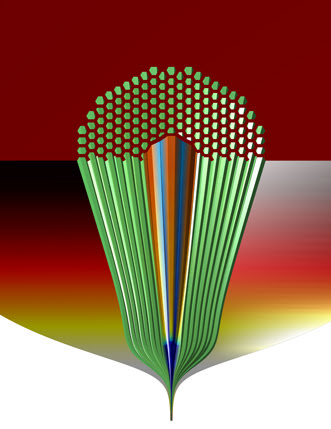SOUTHAMPTON, UK, June 11, 2015 — New fabrication tools have enabled the creation of an 11-km photonic bandgap fiber that previously could only be manufactured in lengths of hundreds of meters.
Its reach, as well as its low loss and a broad transmission bandwidth, make it a candidate for telecommunications applications.
The hollow-core fiber supports >200-nm bandwidth with a longitudinally uniform loss of approximately 5 dB/km at 1560 nm. It has a 19-cell core and five cladding ring structure and was fabricated using a conventional two-stage stack-and-draw technique.

Cross section of a hollow-core photonic bandgap fiber, as generated by a fluid dynamics simulation. The ~1-cm wide preform is drawn down to ~0.2 mm in a hot furnace under gravity and longitudinal tension. The outer glass is colored to show temperature (hottest region in white), while the microstructure is colored to show whether surface tension (blue) or differential pressure (red) forces dominate. Courtesy of Gregory Jasion/University of Southampton.
"Hollow core photonic bandgap fiber has only had niche applications up until now because it was thought that it could not be manufactured in lengths suitable for telecoms applications," said Marco Petrovich, a senior member of the development team at the University of Southampton's Zepler Institute.
The fiber demonstrated error-free, low-latency, direct-detection 10 Gb/s transmission across the entire C-Band, the researchers said.
Manufacturing long lengths of photonic bandgap fiber is notoriously difficult because, unlike conventional fibers whose properties depend on the materials used to make them, the properties of photonic bandgap fibers depend on their structure.
The nodes and struts that give photonic bandgap fiber its properties are usually on a submicron scale, with many even just a few nanometers in size.
"Any small change in these structures can change the properties along the fiber," Petrovich said. "We have shown that our fiber's properties are consistent along its entire length."
The advance was made possible due to an improved understanding of fiber properties deriving from various new numerical and experimental fabrication and characterization tools recently developed by the researchers.
"We demonstrated data transmission at 10 Gb/s along a 11-km span using direct detection, showing only minor penalties and achieving an estimated >15-μs latency reduction relative to standard fiber," Petrovich said. "Our numerical models of the fiber-drawing process give us confidence that much longer fiber yields are feasible through further scaling of the process, and that much lower-loss fibers should ultimately be possible."
Funding came from the U.K. Engineering and Physical Sciences Research Council and the European Union FP7 program.
For more information, visit www.southampton.ac.uk.